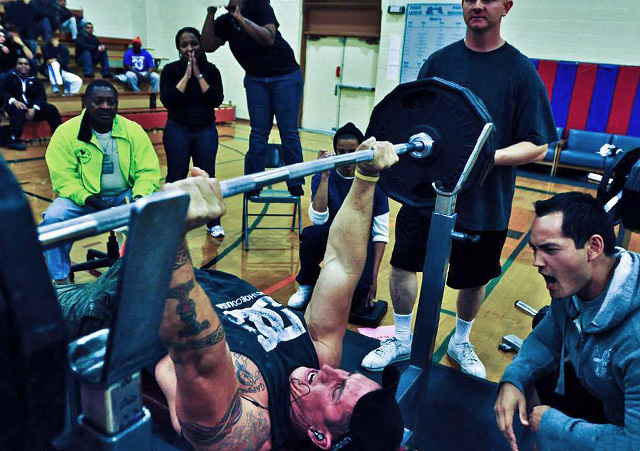A tool that is commonly used in the strength training community is "RIR," which stands for "Reps In Reserve". RIR is a subjective measure of how many more repetitions the athlete thinks they could have performed. RIR can be used as a gauge to manage training intensity and volume of strength training workouts.
 1RM bench press exercise
1RM bench press exercise Using RIR
RIR is often expressed as a number, such as RIR 1, RIR 2, etc. Each number represents the number of reps that could still be performed before reaching failure (or could not complete another repetition with proper form). RIR 1 means you stop with one repetition left in the tank, RIR 2 means you stop with two reps left, and so on. For example, if you're performing a set of squats, and you feel you could perform two more reps before failure, you're stopping with an RIR of 2. This is a subjective estimation, the number of reps that a person has in reserve can vary depending on factors like fatigue, sleep, nutrition, and psychological factors.
- RIR 0 — nothing left, maximal effort (equivalent to 1RM)
- RIR 1 — 1 Repetition Remaining
- RIR 2 — 2 Repetitions Remaining
- RIR 3 — 3 Repetitions Remaining
- RIR 4 — 4 Repetitions Remaining
- RIR 5+ — 5 or more Repetitions Remaining
RIR versus RPE
Repetitions in Reserve (RIR) and Ratings of Perceived Exertions (RPE) are both subjective measures of intensity, though RIR is somewhat less subjective as it's based on the actual number of reps that could be performed.
RPE is a measure of the overall perception of effort and can be applied to many activities, while the RIR is specific to strength lifting exercises and is a feeling of how many more could be completed. RIR is consdiered a more useful measure for resistance exercise, as it can then be used to set workloads and intensity of training workouts.
Zourdos et al. (2016) have created a combined scale, the Resistance Training RPE, with elements of the RPE and RIR scales.
RIR for setting intensity (versus using 1RM)
RIR can be used to design a workout based on training intensity. If the goal is to work with a specific intensity, individuals can adjust the load to achieve a certain RIR value. This is a better alternative to using one-rep max (1RM). Using RIR can help prevent overtraining and reduce the risk of injury associated with training to failure. It also provides a more flexible approach to adjusting training intensity compared to working with fixed percentages of your 1RM.
Benefits of RIR
Using RIR allows individuals to adjust their training intensity and load based on their goals. If the goal is to build strength and power, training with lower RIR values (closer to failure) might be effective. If the goal is to focus on hypertrophy (muscle growth) with slightly less CNS fatigue, training with higher RIR values might be preferred.
You can also use RIR as a tool to help monitor progress. As an individual becomes stronger and more conditioned, they might be able to perform more repetitions with the same weight while maintaining the same RIR. This indicates an increase in strength.
References
- Helms, E. R., Cronin, J., Storey, A., & Zourdos, M. C. (2016). Application of the Repetitions in Reserve-Based Rating of Perceived Exertion Scale for Resistance Training. Strength and Conditioning Journal, 38(4), 42–49.
- Zourdos MC, Klemp A, Dolan C, Quiles JM, Schau KA, Jo E, Helms E, Esgro B, Duncan S, Garcia Merino S, Blanco R. Novel Resistance Training-Specific Rating of Perceived Exertion Scale Measuring Repetitions in Reserve. J Strength Cond Res. 2016 Jan;30(1):267-75.
Related Pages
- Resistance Training RPE — a subjective tool combining RPE and RIR, for determining resistance training intensity levels.
- 1RM Strength Tests — what's the maximal weight you can lift with one repetition?
- Rating-of-fatigue (ROF) — a scale to rate how fatigued someone is feeling.
- Ratings of Perceived Exertions (RPE)
- Testing for strength and power
- Resistance training programs
- Resistance training exercises


 Current Events
Current Events